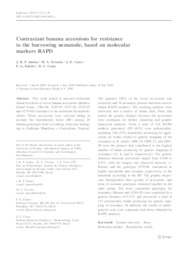Contrastant banana accessions for resistance to the burrowing nematode, based on molecular markers RAPD.
Contrastant banana accessions for resistance to the burrowing nematode, based on molecular markers RAPD.
Author(s): SANTOS, J. R. P.; TEIXEIRA, M. A.; CARES, J. E.; FALEIRO, F. G.; COSTA, D. da C.
Summary: This work aimed to proceed molecular characterization of seven banana accessions (Borneo, Grand Naine, 1304-06, 4249-05, 0337-02, 0323-03 and 4279-06) resistance to the nematode Radopholus similis. These accessions were selected taking in account the reproduction factor (RF) among 26 banana genotypes from a working collection belonging to Embrapa Mandioca e Fruticultura Tropical. The genomic DNA of the seven accessions was extracted, and 36 decamere primers had been used to obtain RAPD markers. The resulting markers were converted into a matrix of binary data. From that matrix the genetic distance between the accessions were estimated, for further clustering and graphic dispersion analyses. From a total of 521 RAPD markers generated, 420 (81%) were polymorphic, including 140 (27%) potentially promising for application on works related to genetic mapping of the resistance to R. similis. OPE-15, OPH-17, and OPG-09 were the primers that contributed to the highest number of bands promising for genetic mapping of resistance (12, 8, and 8, respectively). The genetic distances between accessions ranged from 0.106 to 0.455, with the longest one observed between cv. Borneo and the genotype 4279-06, considered as highly susceptible and resistant, respectively, to the nematode according to the RF. The graphic dispersion distinguished three groups of accessions, and most of resistant genotypes clustered together in the same group. The most contrastant genotypes for resistance (Borneo and 4249-05) were separated by a genetic distance of 0.374, and possessed a total of 114 polymorphic bands promising for genetic mapping of resistance. In addition, the results of pathogenicity tests were congruent with those obtained by RAPD analyses.
Publication year: 2010
Types of publication: Journal article
Keywords: Genetic diversity, Molecular marker, Musa, Radopholus Similis
Observation
Some of Embrapa's publications are published as ePub files. To read them, use or download one of the following free software options to your computer or mobile device. Android: Google Play Books; IOS: iBooks; Windows and Linux: Calibre.
Access other publications
Access the Agricultural Research Database (BDPA) to consult Embrapa's full library collection and records.
Visit Embrapa Bookstore to purchase books and other publications sold by Embrapa.

